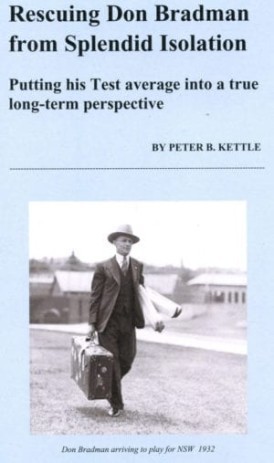Rescuing Don Bradman from Splendid Isolation
Dave Wilson |Published: 2019
Author: Kettle, Peter
Publisher: Peter Kettle & Associates
Rating: 4 stars

When we were researching Masterly Batting, Patrick Ferriday and myself got into an argument over whether or not Peter Willey’s 100* vs West Indies during the summer of 1980 should be included. Our book was limited to Test centuries, and Patrick’s contention was that as the draw was safe before Willey reached his 100 it should be excluded. But my stance was that this wasn’t really an issue of piling on for the sake of it, after all what else was going to happen? England wasn’t going to declare and allow the West Indies to bat again – a draw was England’s only option, Willey was not batting to advance his score, the goal was to secure the draw and prevent the Windies from batting again.
This concept of ‘dead runs’ figures significantly in Peter Kettle’s yeoman effort to ‘put the official Test match batting average of Don Bradman in a true long-term perspective’, as noted at the very beginning of his book ‘Rescuing Don Bradman from Splendid Isolation’. Regular readers will be aware of an earlier review of the book by CW’s own Bradman (at least in terms of output), Martin Chandler. Martin conceded that he was not in a position to comment on the book’s more statistical aspects, and recommended that I take a look.
Like our Masterly Batting exercise, Kettle’s investigation incorporates the application of both objective and subjective methods, involving first removing dead runs (Kettle’s term, not mine), then applying a dominance rating based on how far a batman’s average is above the collective average, that being used to transpose the own era averages into a current equivalent, before finally making an allowance for improvements over time to batting expertise. At the conclusion, he has arrived at a set of ‘egalitarian’ averages.
Kettle has applied these methods, not just to Bradman, but to a select group of 165 Test batsmen. There may be some who take issue with those who have been included or otherwise, but with such as large pool of players any revision would have minimal impact. Kettle has also looked into the issues of weak attacks, standing on the shoulders of giants by inheriting a dominant position, advantageous declarations, first by Bill Woodfull and then Bradman himself while captain, as well as the possibility of ‘enforced terminations’ of Bradman’s innings’. Notably, his conclusions are that Bradman did not benefit greatly as regards weak bowling when compared to other specialist batsmen or from significant opening partnerships.
Kettle’s contention is that the Australians sometimes extended their innings unnecessarily, which had the effect of increasing Bradman’s average to an extent that other batsmen may have been denied opportunities to make substantial scores. After reviewing the scorecards of the matches concerned, I’m not personally convinced that this was always the case, however he and I have access to the same scorecards though reaching different conclusions, so we can agree to differ. I have also arrived at slightly different conclusions regarding the era averages which are used with the dominance ratings to provide a current average, however I don’t think these would materially affect the conclusions. One issue which I agree wholeheartedly with is the decision to discard the post-WW2 part of George Headley’s career.
On the issue of enforced termination, I’m not sure that a captain would impose this, and cannot recall it happening. Declarations are of course a different sort of captain’s decision, though I can’t recall any of the Tests in which Bradman played where Australia declared and where that resulted in a win not being achieved. But I don’t disagree with the premise of dead runs, and Kettle lists not only Bradman’s but all of the top players’ dead runs (though Bradman’s are far higher both in number and proportionally).
The above concerns notwithstanding, I think the methods applied are sound in principle and, although my calculations suggest a slightly different outcome, I think there is much to applaud here. The final averages show a number of players very close now to Bradman (and I wonder if Steve Smith would move even higher after the recent Ashes triumph?) and, although I think the inclusion of some players with very few Tests has diminished Bradman’s standing somewhat, even removing those players Bradman is at the conclusion only around 8% ahead of the next best.
This book is a very interesting read (I hesitate to say entertaining, as the presentation is more like an academic paper than a typical cricket book) and, considering the price, well worth the outlay – I found my copy at Christopher Saunders website for GBP12. I look forward to reading Kettle’s next book, also previously reviewed by Martin, ‘A Plea for Qualitative Justice’.






Leave a comment